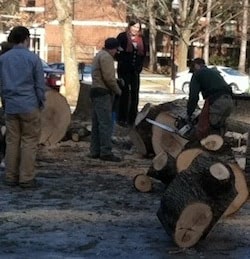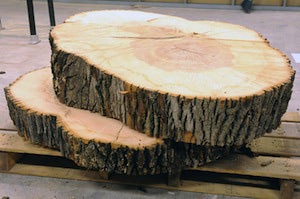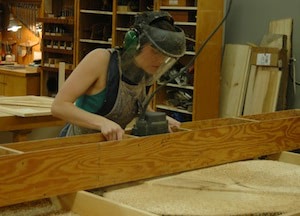- Undergraduate
Bachelor's Degrees
Bachelor of ArtsBachelor of EngineeringDual-Degree ProgramUndergraduate AdmissionsUndergraduate Experience
- Graduate
Graduate Experience
- Research
- Entrepreneurship
- Community
- About
-
Search
All Thayer News
Thayer School's ash tree is gone but not forgotten
Mar 08, 2012
Last month, Thayer School said goodbye to an old friend: the large tree adorning the front of the School since before the construction of Cummings Hall in 1938. “I counted the rings and it was close to one-hundred years old,” said Professor Ulrike Wegst, a materials scientist with a fondness for wood and bamboo. “I could not resist requesting a couple of slices when I saw the arborists with their saws.”

Before

After

Professor Wegst requests some slabs.
"The large white ash had been declining for years,” Said College arborist David DiBenedetto, “We found more faults in the tree structurally and we couldn’t take a chance on any large leaders falling on the commencement tents or pedestrian traffic ... we certainly don't take these trees down without a solid reason for it."
Professor Wegst was not the only one with an eye for the valuable wood. Both she and engineering major Natalie Burkhard '12, made off with a few choice slabs. “Michael West [Thayer Electronics Technician] helped me transport the huge slices that I asked to be cut,” explained Wegst, ”I could not have done it without him and also Gregory Elder, Director of Dartmouth’s Woodworking Shop! The goal is a couple of tables, one for our lab and one for my office, to preserve the memory of this beautiful and historical tree for Thayer.”
Natalie Burkhard '12 works on her table.

Slabs to be turned into tables in the Woodworking Shop.
“Natalie will be graduating this summer,” continued Wegst, “She is working on her incredibly beautiful ash tree slice, which is going to be a table for her as a memento of Thayer and Dartmouth.”
Donning her engineer hat, Wegst also shared a lesson in the materials and mechanics of trees: “The cross-sections of the tree are not only beautiful but also they tell a rather fascinating engineering story. This branch, for example, illustrates how trees change their growth, shape and wood structure to adapt to a new loading condition. Initially, when the branch was young, it was loaded equally from all directions and grew by laying down annual rings of symmetrical thickness. After a few years, the load of the branch increased and it started to lean. The tree responded to this new loading condition with highly asymmetrical growth rings, growing thick layers of ‘reaction’ wood on the upside of the lean, which ‘pulls’ the branch up as if it was a rope and is therefore also termed ‘tension’ wood. Investigating this tension wood further, we would find that not only is the structure and shape of the branch optimized for the new loading condition, but also the wood material itself through an almost parallel alignment of the cellulose fibrils within the wood cell wall. This is what provides the material with both stiffness and strength.”
Initially, when the branch was young, it was loaded equally from all directions and grew by laying down annual rings of symmetrical thickness. After a few years, the load of the branch increased and it started to lean. The tree responded to this new loading condition with highly asymmetrical growth rings, growing thick layers of ‘reaction’ wood on the upside of the lean, which ‘pulls’ the branch up as if it was a rope and is therefore also termed ‘tension’ wood. Investigating this tension wood further, we would find that not only is the structure and shape of the branch optimized for the new loading condition, but also the wood material itself through an almost parallel alignment of the cellulose fibrils within the wood cell wall. This is what provides the material with both stiffness and strength.”

The majestic tree provided shade for picnics and parties.
For contacts and other media information visit our Media Resources page.

